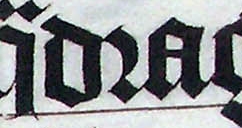
Phi is the 21st letter of the Greek alphabet.
Han unification is an effort by the authors of Unicode and the Universal Character Set to map multiple character sets of the Han characters of the so-called CJK languages into a single set of unified characters. Han characters are a feature shared in common by written Chinese (hanzi), Japanese (kanji), Korean (hanja) and Vietnamese.

The Romanian alphabet is a variant of the Latin alphabet used for writing the Romanian language. It is a modification of the classical Latin alphabet and consists of 31 letters, five of which have been modified from their Latin originals for the phonetic requirements of the language:

O is a letter of the Cyrillic script.

The r rotunda ⟨ ꝛ ⟩, "rounded r", is a historical calligraphic variant of the minuscule (lowercase) letter Latin r used in full script-like typefaces, especially blackletters.

In typography, small caps are characters typeset with glyphs that resemble uppercase letters (capitals) but reduced in height and weight close to the surrounding lowercase letters or text figures. This is technically not a case-transformation, but a substitution of glyphs, although the effect is often approximated by case-transformation and scaling. Small caps are used in running text as a form of emphasis that is less dominant than all uppercase text, and as a method of emphasis or distinctiveness for text alongside or instead of italics, or when boldface is inappropriate. For example, the text "Text in small caps" appears as Text in small caps in small caps. Small caps can be used to draw attention to the opening phrase or line of a new section of text, or to provide an additional style in a dictionary entry where many parts must be typographically differentiated.
Unicode has subscripted and superscripted versions of a number of characters including a full set of Arabic numerals. These characters allow any polynomial, chemical and certain other equations to be represented in plain text without using any form of markup like HTML or TeX.
Unicode has a certain amount of duplication of characters. These are pairs of single Unicode code points that are canonically equivalent. The reason for this are compatibility issues with legacy systems.
The Chinese, Japanese and Korean (CJK) scripts share a common background, collectively known as CJK characters. During the process called Han unification, the common (shared) characters were identified and named CJK Unified Ideographs. As of Unicode 15.0, Unicode defines a total of 97,058 characters.
Standard Sundanese script is a writing system which is used by the Sundanese people. It is built based on Old Sundanese script which was used by the ancient Sundanese between the 14th and 18th centuries. Currently the standard Sundanese script is also commonly referred to as the Sundanese script.

The Unicode Consortium and the ISO/IEC JTC 1/SC 2/WG 2 jointly collaborate on the list of the characters in the Universal Coded Character Set. The Universal Coded Character Set, most commonly called the Universal Character Set, is an international standard to map characters, discrete symbols used in natural language, mathematics, music, and other domains, to unique machine-readable data values. By creating this mapping, the UCS enables computer software vendors to interoperate, and transmit—interchange—UCS-encoded text strings from one to another. Because it is a universal map, it can be used to represent multiple languages at the same time. This avoids the confusion of using multiple legacy character encodings, which can result in the same sequence of codes having multiple interpretations depending on the character encoding in use, resulting in mojibake if the wrong one is chosen.
In Unicode and the UCS, a compatibility character is a character that is encoded solely to maintain round-trip convertibility with other, often older, standards. As the Unicode Glossary says:
A character that would not have been encoded except for compatibility and round-trip convertibility with other standards
Many Unicode characters are used to control the interpretation or display of text, but these characters themselves have no visual or spatial representation. For example, the null character is used in C-programming application environments to indicate the end of a string of characters. In this way, these programs only require a single starting memory address for a string, since the string ends once the program reads the null character.
A numeral is a character that denotes a number. The decimal number digits 0–9 are used widely in various writing systems throughout the world, however the graphemes representing the decimal digits differ widely. Therefore Unicode includes 22 different sets of graphemes for the decimal digits, and also various decimal points, thousands separators, negative signs, etc. Unicode also includes several non-decimal numerals such as Aegean numerals, Roman numerals, counting rod numerals, Mayan numerals, Cuneiform numerals and ancient Greek numerals. There is also a large number of typographical variations of the Western Arabic numerals provided for specialized mathematical use and for compatibility with earlier character sets, such as ² or ②, and composite characters such as ½.

Multiocular O is a rare glyph variant of the Cyrillic letter O. This glyph variant can be found in a single 15th century manuscript, in the Old Church Slavonic phrase "серафими многоꙮ҄читїи҄". It was documented by Yefim Karsky from a copy of the Book of Psalms from around 1429, now found in the collection of the Trinity Lavra of St. Sergius.

Monocular O is one of the rare glyph variants of Cyrillic letter O. This glyph variant was used in certain manuscripts in the root word ꙩко (eye), and also in some other functions, for example, in the word- and syllable-initial position. It is used in some late birchbark letters of the 14th and 15th centuries, where it is usually differentiated from a regular о, used after consonants, also by width, being a broad On (ѻ) with a dot inside.

Binocular O is one of the exotic glyph variants of Cyrillic letter O. This glyph variant can be found in certain manuscripts in the plural or dual forms of the root word eye, like Ꙫчи.
A variant form is a different glyph for a character, encoded in Unicode through the mechanism of variation sequences: sequences in Unicode that consist of a base character followed by a variation selector character.
CJK Unified Ideographs Extension B is a Unicode block containing rare and historic CJK ideographs for Chinese, Japanese, Korean, and Vietnamese.









